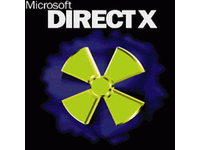OpenGL 3 & DirectX 11: The War Is Over
Introduction
Given the prevalence of DirectX nowadays, we tend to forget that 10 years ago an all-out war was being waged between Microsoft and Silicon Graphics in the field of 3D APIs. The two companies were both trying to win over developers, with Microsoft using its financial muscle and SGI relying on its experience and its reputation in the field of real-time 3D. In this modern David-versus-Goliath battle, the “little guy” won a precious ally in one of the most famous game developers–-Mr. John Carmack. In part due to the success of the Quake engine, solid support for OpenGL became important enough to motivate makers of 3D cards to provide complete drivers. In fact, it gave 3dfx one of its early advantages and knocked ATI to the back of the pack as it struggled with its OpenGL support.
Meanwhile, Microsoft was starting from scratch, and the learning curve was steep. So, for several years, Direct3D’s capabilities were beyond the curve, with an interface that many programmers found a lot more confusing than OpenGL’s. But nobody can accuse Microsoft of being easily discouraged. With each new version of Direct3D, it gradually began to catch up with OpenGL. The engineers in Redmond worked very hard to bring performance up to its rival API’s level.
A turning point was reached with DirectX 8, released in 2001. For the first time, Microsoft’s API did more than just copy from SGI. It actually introduced innovations of its own like support for vertex and pixel shaders. SGI, whose main source of revenue was the sale of expensive 3D workstations, was in a bad position, having failed to foresee that the explosion of 3D cards for gamers would prompt ATI and Nvidia to move into the professional market with prices so low (due to economies of scale) that SGI couldn’t keep up. OpenGL’s development was also handicapped by bitter disputes among its proponents. Since the ARB—the group in charge of ratifying the API’s development—included many different, competing companies, it was hard to reach agreement on the features to be added to the API. Instead, each company promoted its own agenda. Conversely, Microsoft was working solely with ATI and Nvidia, using its weight to cast a deciding vote if there was disagreement.
With DirectX 9, Microsoft managed to strike a decisive victory, imposing its API on developers. Only John Carmack and those who insisted on portability remained faithful to OpenGL. But their ranks dwindled. And yet a reversal of fortunes was still possible. It had happened with Web browsers, after all. Even when a company has maneuvered itself into a near monopoly, if it rests on its laurels, it’s not all that rare for a competitor to rise from his ashes. So when the Khronos group took over OpenGL two years ago, many hopes were rekindled with all eyes on the upcoming SIGGRAPH conference that year.
Last month, Khronos was to have announced OpenGL 3, a major revision of the API that’s supposed to catch up with Microsoft, which was also scheduled to launch its next-gen DirectX 11 API. But things didn’t really go as planned.
Get Tom's Hardware's best news and in-depth reviews, straight to your inbox.
Current page: Introduction
Next Page OpenGL 3 (3DLabs And The Evolution Of OpenGL)-
Gatekeeper_Guy Cool, but it will be a few years before we see at DX11 graphic card on the market.Reply -
stridervm Sadly, I agree by the author's opinions. Not simply for, but because it still give away the idea that PC gaming cannot be considered serious..... Unless you're using Windows, which is proprietary, the only viable alternative cannot be used because of the fear of losing compability. I just hope this can be remedied before Microsoft becomes.... Unreasonable and becomes power hungry..... If it isn't already. Look at how Windows systems cost now compared to the the alternative.Reply -
johnbilicki DirectX 11 will be available on Windows 7 and Vista? Great news indeed! Normal noobs will be able to own super noobs who are standing around looking at over-detailed shrubs.Reply
As for real gamers, we'll stick with XP until either Microsoft gets smart and clones XP and only adds on Aero or OpenGL gets it's act together and Linux becomes a viable gaming platform. It would be nice if it became a viable anything-other-then-a-web-server viable platform though. Linux gurus, feel free to let us know in sixty years that I won't have to explain to my grandmother how to type console commands to install a copy of Opera.
OpenGL can go screw backwards compatibility, look what it's done to (competent) web designers who are stuck dealing with Internet Explorer.
All the bad news about DirectX, OpenGL, and DRM makes me wonder if these companies want us to pirate the hell out of everything. At this rate "next generation" consoles might actually become the next generation consoles! -
jimmysmitty Gatekeeper_GuyCool, but it will be a few years before we see at DX11 graphic cardhttp://en.wikipedia.org/wiki/Video_card on the market.Reply
I thought the article said that DX11 is supposed to be compatable with previous gen hardware.
I know the Gemoetry Shader with Tesselation is already in all of the ATI Radeon HD GPUs so thats one thing it will support.
But no SP 5.0 support. I have heard that Intels GPU, Larrabee will support DX11. So that would mean late 2009/2010 will have at least one and that should mean that ATIs HD5K series and nVidias next step should includ support if they were smart and jumped on the wagon early. -
OpenGL may not have gotten the changes it needed to compete with DirectX as a gaming graphics API. But then you have people like Tim Sweeney telling us that graphics APIs are not going to be relevant that much longer (http://arstechnica.com/articles/paedia/gpu-sweeney-interview.ars).Reply
Direct3D 10 has changed very little in the industry so far, predictably only a very small number of games us it. And those who do can do most of it on Direct3D 9 as well. Maybe MS learned by now that releasing a new API on only the latest platform is a huge mistake, but it will still be a while before people will adapt their new API. And if Tim Sweeney's predictions come true, it will likely not happen at all. -
martel80 johnbilickiLinux gurus, feel free to let us know in sixty years that I won't have to explain to my grandmother how to type console commands to install a copy of Opera.I have been able to "accidentally" (because I'm no Linux guru, you know) install Opera through the Synaptic Package Manager on Ubuntu. So please, stop talking nonsense. :)Reply
The process was a bit different but overall faster than under Windows. -
dx 10 may not appear major but for devs its actually is.. no more checking cap bits.. that is a big improvment. dx10 is alot more strict in terms of what the drivers should do and thats good. doing away with fixed functions is also greatReply
however hardware tesselation if huge.. dx 11 also allows for hardware voxel rendering /raymarching thru compute shaders and alot of other stuff.. as apis become more general im sure the pace of new apis: will slow down, but that's not a indicator that pc gaming is dying (un informed people have claimed that the pc is dead since the ps1)
as for the windows/other platforms discussion, it is not the fault of microsoft that there is no viable alternative on other platforms. if someone chose to compete with microsoft, they could. but no one seems willing. what really should be done is a port/implementation of dx11 in open source..
however, in the cut throat buisness of game engines and gpu drivers, i seriously doubt that open source systems will ever be at the forefront of gaming -
phantom93 DX11 is compatiable with DX10 hardware. It should work when it is released unless they have bugs.Reply -
spaztic7 From my understanding, all HD4800 serious are DX11 compatible... and the HD4800 line is ray tracing compatible at ray tracings frame cap. I do not know about the 4600 line, but I don’t see why they wouldn’t be.Reply -
GAZZOO ow PC gameing is dieing allright the major game componies are starting to squeese out the PC games from there production list useing the excuse that they are loosing money through pirecy but what they are realy doing is cutting out one version forcing PC gamers to evolve into console playersReply
And from this article I get the impresion that microsoft has a hand in it aswell by making sure that the console games end up running better or as good as PC games
I think if the origenal Opengl was alowed to proceed years ago and if the follow up was taken and there wasnt any sabotage happening then the PC and its performance with mutly CPU GPU and the tecnolegy evolving with the progamers and propper apis in this area would have left the console market in the shade but this way Microsoft is eliminating other similar competion Apple
To cut to the chace Apple and OpenGl is getting the Microsft squeese and who has an interest in a console product :-)
I guess I might be one of the old dinosorse but I still am a PC gamer through and through even though I am grampar foda I love buiding PC units and playing well I havent been to a net game in a couple of years Pizza and beer he he heee But Il be buggered If I will lie down and die because of big buisness
Gazza



